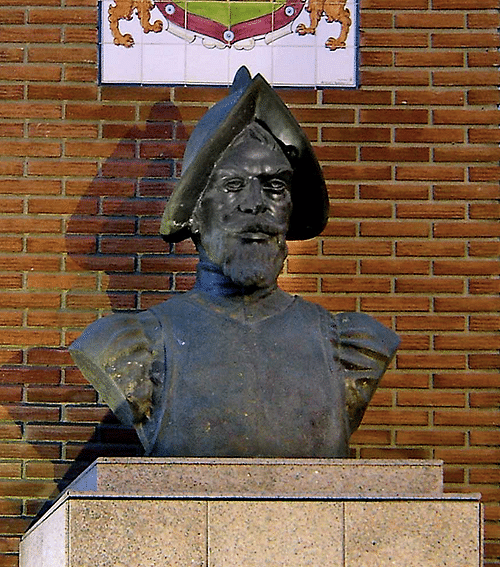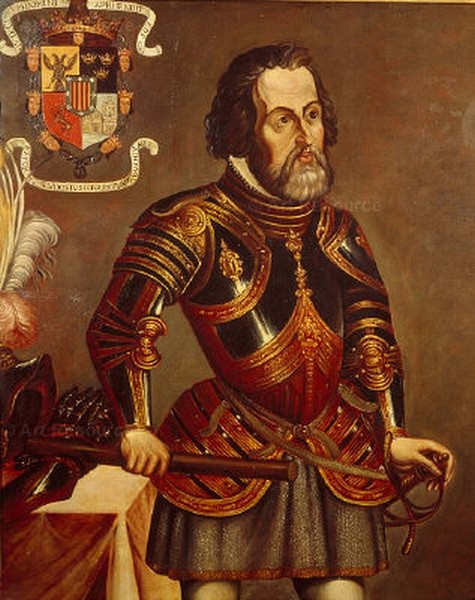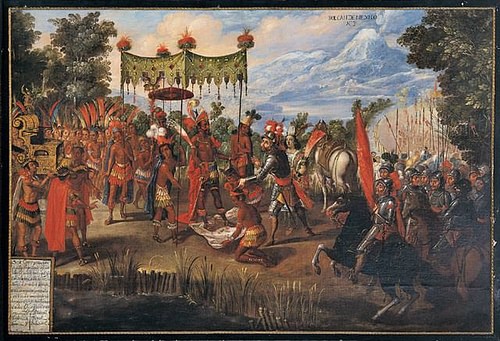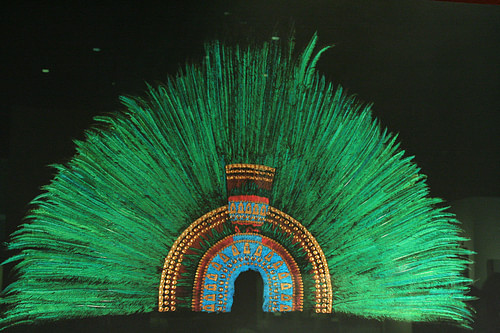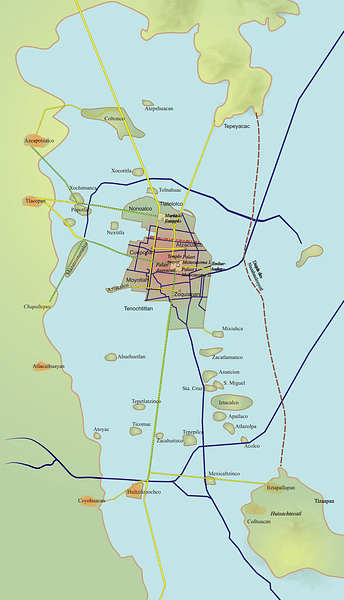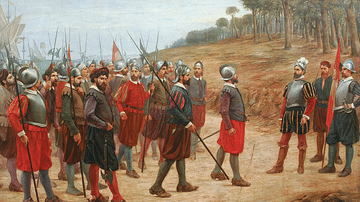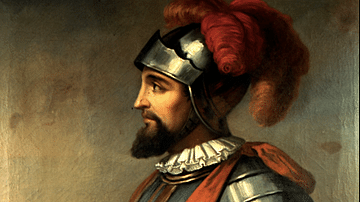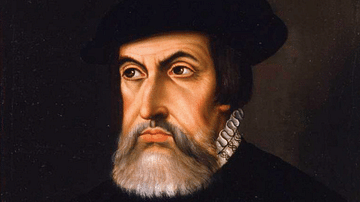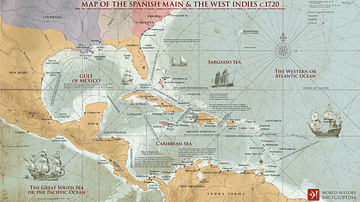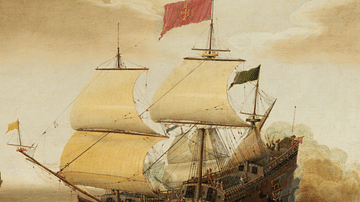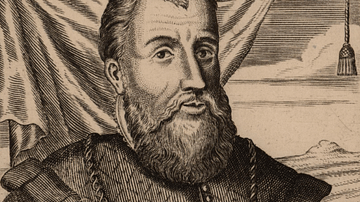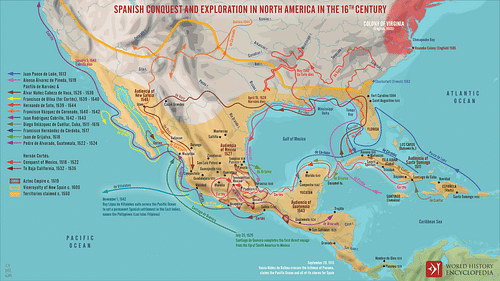
The Conquest of New Spain by Bernal Díaz del Castillo (1492 to c. 1580) is an account written in 1568 of the early Spanish colonization of Mesoamerica, specifically the conquest of the Aztec civilization in Mexico from 1519 to 1521 when Díaz was a member of the conquistador expedition led by Hernán Cortés (1485-1547).
Bernal Díaz
Díaz was born in 1492 in Medina del Campo, Valladolid, in Spain. Like many young men of his generation, he sought his fortune in military escapades in the New World. Díaz was in Nombre de Dios in Panama in 1514 where he served Pedro Arias de Avila (aka Pedrarias Dávila, b. 1442). In 1517, Díaz moved on to Cuba where he served under another infamous colonial governor, Diego Velázquez de Cuéllar (1465-1524). Velázquez was keen to find out more about the Yucatán Peninsula – then considered just another Caribbean island. Cuéllar sent two expeditions of exploration to Mexico: one in 1517 led by Francisco Hernández de Córdoba (1474-1517) and another in 1518 led by Juan de Grijalva (1489-1527). Díaz was on both expeditions as an ensign, and they have a chapter each devoted to them in Díaz's chronicle, but it is inconsistencies in the geography of these expeditions which have led some to doubt Díaz's participation.
Velázquez was so intrigued by the reports of the first two expeditions concerning a large civilization to the west that he determined to send out a third reconnaissance mission, this time to be led by Hernán Cortés. Díaz went on this expedition in 1519, but Cortés was ambitious for much more than information and was intent on conquest and riches.
After the campaign against the Aztecs, Díaz had an official position in Guatemala which included an encomienda license to extract labour from the indigenous community. Díaz visited Spain again but ultimately returned to Guatemala to write his famous work in the last years of his eventful life. The original title in Spanish is Historia verdadera de la conquista de la Nueva España ("The True History of the Conquest of New Spain"). New Spain was the name given to the viceroyalty that the Spanish established in 1535, of which Mexico was a part.
The work was first published in 1568, almost 50 years after the events the book describes. Díaz was 76 at the time, and this may explain some of the inconsistencies that have preoccupied modern historians. The doubts are a little ironic since one of the primary motivations for Díaz to take up his pen was to set the record straight. Díaz did not agree with a recent publication by Francisco López de Gómara (1511 to c. 1566), Herńan Cortés' private chaplain and final confessor. He felt that López's General History of the Indies (Historia General de las Indias), written in collaboration with Gonzalo de Illescas, had not got all the details of the Aztec conquest right and that Cortés had not been represented accurately. Díaz claimed that López had never even been to the Americas while he had been an eyewitness at every major battle. Díaz frequently criticises and corrects these chroniclers in his own work, and he is keen to show that the conquest was a team effort of conquistadors and not just Cortés, who Díaz felt had gained too much credit at the cost of his colleagues. A further motivation for Díaz was that his account, in which he is keen to show his role in the conquest, in some sense justified his encomienda, which at that point risked being abolished by a new set of laws.
Díaz died around 1580, having outlived all his old conquistador companions, but at least, in the words of the English translator J. M. Cohen, having recorded his version of events for posterity by displaying "a graphic memory and a great sense of the dramatic" (7).
Book Summary
The First Voyage
Díaz opens his work with a prologue stating: "What I myself saw, and the fighting in which I took part, with God's help I will describe quite plainly, as an honest eyewitness, without twisting the facts in any way." Díaz candidly summarises the motivation and objectives of the conquistadors: "to serve God and His Majesty, to give light to those who were in darkness, and to grow rich, as all men desire to do" (ch. 174 in the original).
The first part of the narrative covers the first expedition to Mexico led by Cordóba in 1517. Díaz explains that he signed up because, after three years in the Caribbean, he had not made any steps toward gaining the fortune he had hoped to find in the New World. The adventurers hoped above all to find gold, silver, and pearls in unexplored lands. Encountering the local inhabitants, fighting broke out, but the visitors did find examples of gold, well-built masonry, blood-covered altars, and strange idols, all suggesting this was the fringe of a great civilization. In another violent encounter, Díaz was wounded by three arrows, and Cordóba died of his multiple wounds. Two prisoners were taken and were named Melchior and Julian; the pair would function as invaluable interpreters in the next expeditions.
The Second Voyage
With nothing to show for his adventure except bitter experience, Díaz was "reduced to poverty" (26) and so willingly joined the second expedition sent out by Velázquez in 1518. Grijalva led around 250 men in four ships. Another violent encounter occurred when contact was made with the mainland and indigenous peoples. The Spaniards caused havoc with their cannons, but many on the expedition were again wounded by arrows: "Grijalva received three arrow wounds and had two of his teeth broken; and more than sixty of us were wounded" (30). Again the visitors came across evidence of local religious practices:
On shore there were some stone buildings used as prayer-houses, which contained many idols of baked clay, wood, and stone. Some of them were female figures others represented serpents, and there were many deers' antler.
(30)
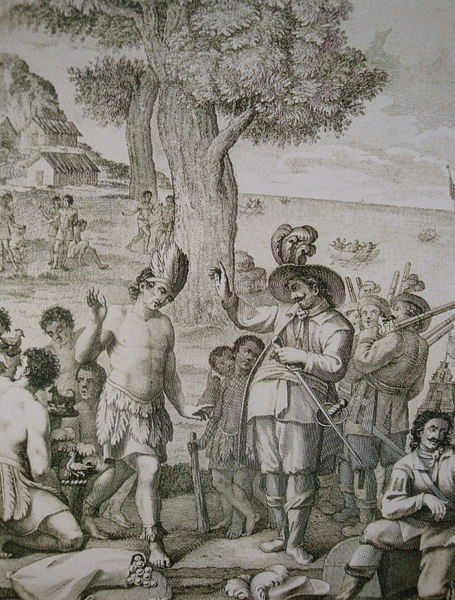
Later, they came across more indications of religious rites on a small island:
We found two stone buildings of good workmanship, each with a flight of steps leading up to a kind of altar, and on those altars were evil-looking idols, which were their gods. Here we found five Indians who had been sacrificed to them on that very night. Their chests had been struck open and their arms and thighs cut off, and the walls of these buildings were covered with blood.
(37)
Far from arousing any anthropological-like interest, these sights only confirmed the conquistadors' belief that they were in the right place to fulfil their duty and spread the Christian faith, one of the major justifications for conquest. Some peaceful trade went on, the Spanish offering glass beads and other trinkets for food like maize cakes and pineapples, as well as a few items made of gold. These latter items were the other justification for further conquest: stripping the wealth of the continent and shipping it to Spain. The Tabasco river was found and renamed the Rio de Grijalva. A good natural harbour was discovered, mapped and sounded – this would later become the major colonial port of Veracruz. In short, the findings of the expedition were sufficiently promising for Velázquez to send out a third mission, this time led by Hernán Cortés, who looked rather splendid in the role: "He wore a plume of feathers, with a medallion and a gold chain, and a velvet cloak trimmed with loops of gold. In fact, he looked like a bold and gallant Captain" (47).
Cortés & the Burning of the Ships
According to Díaz, Cortés left Cuba in 1519 with 500 fighting men under his command. Eleven ships were packed with stores, weapons, and 16 horses. Upon landing and making their way into the interior, the usual battles with indigenous tribes followed, but the Spanish cavalry, steel, and gunpowder weapons proved an invincible combination compared to arrows and slings. A man called Aguilar, who looked like an Indian but was in fact a captured Spaniard who had been adopted by a local tribe, proved to be a great find as an interpreter. Then they captured a woman called Malintzin (aka Doña Marina or La Malinche), a Maya woman who spoke the Nahuatl language of the Aztecs and a local Mayan language which Aguilar could translate. The way was now open for Cortés to mix warfare and diplomacy as he progressed deeper into Mesoamerica.
Eventually, contact was made with representatives of the Aztec ruler Motecuhzoma (aka Montezuma, r. 1502-1520). Gifts were exchanged, the Spanish giving cotton shirts, a glass cup, and glass beads, while the Aztecs gave quetzal feathers, rolls of fine textiles, and various items of gold and silver. Moving further inland, Cortés battled with and then made allies of the Totonecs, who were keen to see the downfall of the Aztec Empire. Meanwhile, a fort and church were built at Veracruz as the conquistadors established a permanent base there. It was at Veracruz that Cortés made an extraordinary decision in consultation with his men, as explained by Díaz:
The ships were destroyed with our full knowledge and not, as the historian Gomara alleges, in secret. Then one morning after mass, during a general discussion on military matters, after courteously begging for our attention, Cortes made a speech to the effect that we now understood what work lay before us…we could look for no help or assistance except from God, for now we had no ships in which to return to Cuba. Therefore we must rely on our own good swords and stout hearts.
(131)
Defeating the Tlascalans
Cortés led his men and allies inland, but the trail was not easy:
We completed our ascent of the mountains and entered uninhabited country where it was very cold, and where it rained and hailed. That night we were very short of food, and a wind blew off the snowy heights on one side of us that made us shiver with cold…[we] had nothing but our armour for covering.
(135)
They moved on into the territory of the Tlascalans, a people subject to the military rule of the Aztecs. In September 1519, there were ambushes and open battles, but the capture of certain Tlascalan chieftains eventually meant Cortés was able to bargain for peace. The Tlascalans, no friends of the Aztecs, were keen to help the Spaniards overthrow them. Gifts were exchanged, young women were offered to the Spaniards, and, most importantly of all, the Tlascalans described in detail the strategies of Aztec warfare and the secrets of their capital Tenochtitlan, a great city built on a lake and entered via many bridges and causeways. The Aztecs were very careful to control such materials as salt, silver and gold, and these could be found in vast quantities in storerooms in the city. At last, the conquistadors had found just what they had all left Cuba to find.
Meeting Montezuma
When the conquistadors arrived at Cholula, a battle ensued with Aztec forces, which they won with Tlascalan help. Díaz describes this area of Mexico in a rare diversion from the military and political events:
Cholula is situated on a plain with many other towns around it…It is a land rich in maize and other vegetables, and in peppers, and in the maguey from which they brew their wine. They make very good pottery in this district, of red and black and white clay, painted in various designs, and they supply Mexico and all the neighbouring provinces with it.
(201-2)
In a change of strategy, ambassadors from Montezuma reached the Spaniards, who were invited to peacefully enter Tenochtitlan on 8 November. It seemed that neither side was quite sure how to proceed, but for the moment, the peaceful overtures drowned out those who screamed for war. The capital might have been a trap, but it was certainly an engaging one. The Spaniards could not believe their eyes at this great metropolis with its towering temple pyramids, giant causeways, floating rose gardens, and sweet-smelling trees. The most magnificent sight of all, though, was Montezuma himself:
The great Montezuma descended from his litter…beneath a marvellously rich canopy of green feathers decorated with gold work, silver, and pearls…Montezuma was magnificently clad, in their fashion, and wore sandals…the soles of which were of gold and the upper parts ornamented with precious stones…[lords] walked before the great Montezuma, sweeping the ground on which he was to tread, and laying down cloaks so that his feet should not touch the earth. Not one of these chieftains dared to look him in the face.
(217)
Cortés gave a necklace of scented beads to the Aztec ruler; in return, he was presented with a necklace of golden crabs and invited to make himself at home in the royal palace of Montezuma's father Axayácatl (r. 1469-1481), as it happened, also the treasure store of the empire. Montezuma seemed determined to give as many expensive gifts as possible to his visitors, perhaps in the hope they would be satisfied and go back to where they had come from. On the other side, the Spaniards were now keener than ever to enrich themselves. They helpfully explained that they represented Charles V, Holy Roman Emperor (r. 1519-1556), and the basics of the Christian religion.
Díaz goes on to give the following physical description of the Aztec ruler:
The great Montezuma was about 40 years old, of good height, well proportioned, spare and slight, and not very dark, though of the usual Indian complexion. He did not wear his hair long but just over his ears, and he had a short black beard, well-shaped and thin. His face was rather long and cheerful, he had fine eyes, and in his appearance and manner could express geniality or, when necessary, a serious composure. He was very neat and clean, and took a bath every afternoon. (224-5)
Díaz describes life in the royal palace, the food eaten, and the daily ceremonies. In entertaining passages, he describes the armoury, the palace's aviary, menagerie, and the craft workshops, as well as the enormous street market outside, the temples with their great statues, and the fine masonry of the city's architecture.
Taking Montezuma Prisoner
As the Spanish persisted with their evangelism, Montezuma grew angry at the disparagement of the Aztec gods and the insistence by Cortés that the great temple pyramid would look very fine with a statue of the Virgin Mary on top of it. Despite the Spaniards being in an alien city surrounded by tens of thousands of potential enemies, Cortés audaciously decided to take Montezuma prisoner, removing him from his palace and keeping him where the Spaniards had been quartered. In a somewhat bizarre stalemate, Montezuma thus found himself under house arrest but still attended by his family and servants; he was even able to take his daily bath. Meanwhile, the Spaniards shared out the royal treasury amongst themselves. The Aztec nobles did not seem to know what to do in this entirely novel situation but were wary of the weapons the Spaniards had used so effectively at Cholula. The spell was broken when Montezuma's relatives decided he was no good to anyone and they were better placed to rule the Aztec Empire. Meanwhile, events elsewhere changed the entire state of the game.
The Battle for Tenochtitlan
Velázquez had sent a force under the command of Pánfilo de Narváez to Veracruz to apprehend Cortés for exceeding his authority in trying to conquer an empire all by himself. Cortés was obliged to face these competitors for treasure, and so, in May 1520, he left Tenochtitlan in the hands of a small Spanish force under the command of Pedro de Alvarado (c. 1485-1541). Cortés easily met the threat posed by Narváez, most of whose men joined him. Meanwhile, back in Tenochtitlan, Alvarado had sparked off a war, when fearing mischief, he had massacred a large number of Aztec dignitaries during a religious ceremony. On 24 June, Cortés was back in Tenochtitlan. Montezuma was tasked with calming the populace but was killed by a thrown rock. The Spanish became trapped in the palace of Axayácatl, but Cortés managed to flee the city in a running night battle on 30 June 1520. This bloody retreat became known as the Noche Triste ('Sad Night'). The Spaniards then won a great victory in July near Otumba. After several more campaigns, and receiving reinforcements by sea, several cities were captured, notably Texcoco on 31 December 1520. Cortés began a lengthy siege and recaptured Tenochtitlan, helped by thousands of Tlascalan allies and a number of wooden ships the Spaniards had reassembled on the waterways of the Aztec capital.
The final part of the book covers further conquests in Mexico and Honduras, the later career of Cortés, and Díaz's own attempts to gain recognition back in Spain. Most English editions omit these latter sections and end with the successful capture of Tenochtitlan in August 1521, which became the capital of New Spain. For Díaz and others, the whole escapade ended in disappointment. The loss of treasure into Lake Texcoco during the Noche Triste meant that "we captains and soldiers were all somewhat sad when we saw how little gold there was and how poor and mean our share would be" (419). It was scant reward for years of hardship, battles, and near scrapes with death and disease.
Legacy
Díaz's account has become an essential element of the history of this period. There are some discrepancies with other chronicles such as the rivalry between Cortés and Velázquez, and one or two events have been mixed up chronologically (perhaps the fault of long-dead archivists rather than always Díaz's). Several minor details do not match, for example, Cortés' own account, but these are usually noted in good modern translations, and the fundamental story is considered accurate, at least from the Spanish point of view, which was, of course, the victor's view.
The work is also an invaluable record of the Spanish language of the period since it is written in a much less formal style that was usual for similar works of the period, one of the reasons why it is still read today while other, more learned treatments have been left to gather dust on the library shelf.
